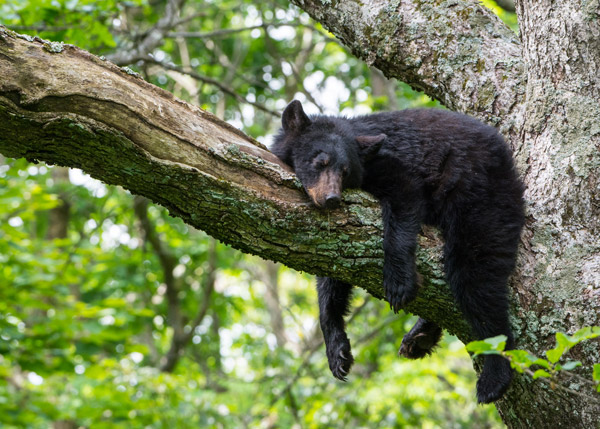This article was featured in the 2015 winter edition of The Piedmont Virginian.
A nationwide decline in hunting, combined with hunting restrictions in heavily populated areas has helped to increase black bear populations.
According to Chippewa legend, a long time ago there was a large forest fire on the shores of Lake Michigan. It forced a mother bear and her two cubs into the lake in an attempt to escape the flames. The mother bear eventually swam to the opposite shore, but could not find her cubs. Fatigued, the mother bear lay down on top of a bluff and waited for her cubs to arrive. Unfortunately they had perished in the lake. But the Great Spirit had been watching, and as recognition for the mother bear’s unwillingness to give up, two islands (North and South Manitou islands) were created in their memory. The Great Spirit called up the winds and they buried the sleeping mother bear under a sand mound, which still stands. This is how Sleeping Bear Dunes National Lakeshore in Michigan earned its name.

Many Native American tribes have legends centered around the black bear. The black bear was a symbol of wisdom, protection, and strength, and was frequently adopted as a “clan animal” for many tribes. Like 21st century Americans, these early Native peoples lived alongside the black bear. Black bears, or Ursus americanus, are still viewed by many today as a species that embodies strength and mystery. The American black bear is one of three bear species found in North America, and the only one found in Virginia. Although it shares a continent with the brown bear and the polar bear, it is more genetically similar to the Asian black bear and the sun bear (found in tropical forests of Southeast Asia). Black bears have historically inhabited the vast forests of North America. However, they have shown remarkable versatility in the face of urbanization and can now be found comfortably living next door to American suburbia.
Since the black bear is a generalist species (able to thrive in a wide variety of environments) and an omnivore, it joins the list of other well-off generalists like the whitetailed deer, raccoon, grey squirrel, and coyote that have learned to be successful in human-dominated environments. Similar to the white-tailed deer, it wasn’t always a success story for the black bear. Black bears numbered around 2 million nationwide in the pre-colonization era, but their populations were knocked down to around 200,000 by the turn of the century as a result of wide scale habitat loss (clearing of land for agriculture) and over-hunting. Today there are about 900,000 black bears in the U.S.
The black bear’s rise is owed to several factors. The reversion of agricultural lands back to forest provided black bears with habitat and a source of acorns and other nuts (a favorite fatty food for bears bulking up for the winter). The establishment of Shenandoah National Park helped to preserve habitat for black bears in our state in particular. Additional food sources in the form of dumpsters, bird feeders, and garbage cans allowed for successful hibernation and reproductive rates. Black bears have an interesting reproductive process known as delayed implantation. Female bears mate in the summer, around June or July. The embryo is fertilized but does not implant into the uterine wall and begin development until the winter during hibernation. However, if the female bear did not have the ability to secure enough body fat for hibernation, the embryo never implants and she does not have cubs that year.
A nationwide decline in hunting, combined with hunting restrictions in heavily populated areas has also helped to increase black bear populations. In Virginia, there are bow, muzzleloader, and firearms seasons for black bear that run October through early January in most counties. Our hunting season coincides with a period of high activity for black bears. Throughout the fall and early winter, bears are eating as much fatty foods as possible in order to prepare for hibernation. An increase in property damage as bears rifle through garbage cans, dumpsters, garages, crop fields, and livestock in an attempt to obtain calories, usually causes conflicts between black bears and humans.
While there have been two significant black bear attacks in the Mid-Atlantic this year (one in George Washington National Forest and one in New Jersey), fatal attacks on humans continue to be incredibly rare. In fact, you are more likely to be killed by a dog, lightning strike, or by riding a bike, then you are to be killed by a black bear.
